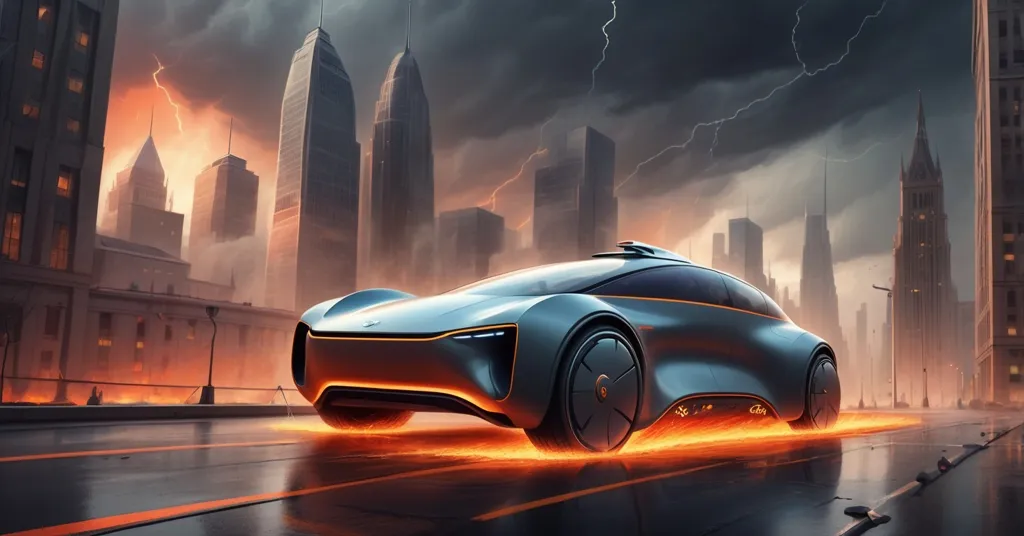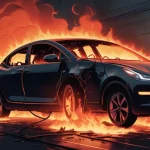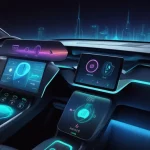Tesla Sales Plunge in Europe, Faces $243M Autopilot Lawsuit in U.S.

Tesla’s Rough Ride: Sales Crash in Europe, Legal Battles Flare in the U.S.
Tesla, the electric vehicle (EV) giant and darling of disruptive tech, is slamming into serious headwinds on two continents. In Europe, sales are tanking—especially in Germany, where registrations nosedived over 55% in July—while competitors like BYD are surging ahead. Across the pond, a $243 million court ruling over a fatal 2019 Autopilot crash in Florida has reignited safety concerns, just as Tesla pushes its ambitious robotaxi beta. Let’s unpack the mess and see what it means for innovation, trust, and the broader ethos of disruption we champion.
- Europe Sales Collapse: Tesla’s German registrations dropped over 55% in July, with a year-to-date decline of nearly 58%.
- U.S. Legal Hit: A Florida court awarded $243 million to families over an Autopilot-related crash, spotlighting safety flaws.
- Robotaxi Rollout: A limited beta launched in Austin, but regulatory delays and public skepticism threaten Musk’s lofty timeline.
Europe’s Cold Shoulder: Tesla Loses Ground
In Germany, a powerhouse market for EVs, Tesla’s numbers are downright ugly. The company registered just 1,110 vehicles in July, a brutal 55% plunge from the same month last year, according to Kraftfahrt-Bundesamt (KBA) official statistics, Germany’s vehicle licensing authority. Year-to-date through July, registrations are down nearly 58% to around 10,000 units. This isn’t a market-wide slump—Europe’s EV sales are booming, with battery electric vehicle (BEV) registrations in Germany alone jumping 53.5% year-on-year in April 2025, hitting an 18.8% market share. So, while Europeans are snapping up electric cars, they’re steering clear of Tesla, even after the refreshed Model Y “Juniper” update rolled out. What gives?
Let’s break it down. First, there’s the Elon Musk factor. Tesla’s CEO has a knack for stirring controversy with his political hot takes, and in eco-conscious Europe, where social values often drive purchases, his outspoken nature is alienating buyers. Musk’s Twitter rants might fire up some fans, but they’re a PR disaster in a region that prizes sustainability over bravado. Second, regulatory friction isn’t helping. Europe’s stringent emissions and safety standards are a tightrope, and Tesla’s been slow to adapt, unlike rivals who’ve mastered the local game. Then there’s the 800-pound gorilla: competition. Chinese automaker BYD is obliterating Tesla, posting a fivefold increase in German registrations for July at 1,126 units, with a year-to-date tally of 7,449—also up over five times from last year. Globally, BYD surpassed Tesla in BEV sales for 2024, leveraging lower costs (think models $10,000 cheaper than Tesla’s base offerings) and aggressive expansion backed by China’s supply chain muscle, as detailed in this comparison of BYD and Tesla’s growth.
Some context for the uninitiated: the European EV market has matured since subsidies like Germany’s Umweltbonus—a cash incentive for EV buyers—ended in 2023. Without that carrot, consumers now hunt for value and variety over brand hype. Tesla’s premium pricing (often $50,000+ for a Model 3 or Y) feels out of step when BYD and others offer comparable range and tech for less. Add operational hiccups—like delays in ramping up the Model Y Juniper production—and Tesla looks like a heavyweight stumbling in a lightweight bout. Drew Kodjak, president of the International Council on Clean Transportation, nailed it when he said Chinese automakers are forcing global players to “accelerate their own transitions or risk losing competitive ground.” Tesla’s losing ground fast, and further analysis of Tesla’s sales decline in Europe paints a grim picture—can it pivot, or is this a structural crack in its dominance?
U.S. Courtroom Reckoning: Autopilot Under Fire
Across the Atlantic, Tesla’s fight isn’t about showroom numbers—it’s about courtroom verdicts. A Florida court recently hammered the company with a $243 million award to families of two victims killed in a 2019 crash involving a Tesla Model S on Autopilot, as reported in this detailed legal analysis. The jury pinned 33% of the blame on Tesla, citing flaws in the driver-assistance system. For those new to the tech, Autopilot is Tesla’s semi-autonomous driving feature, meant to handle steering, acceleration, and braking under human supervision, though its safety issues are well-documented. But this ruling screams that the system—and Tesla’s safety claims—aren’t as bulletproof as advertised. Aaron Davis, a legal partner at a Washington firm, put it bluntly:
“Now there’s essentially an opinion that some aspect of Tesla’s business is not safe and maybe the safety that the company advertises isn’t what it’s cracked up to be.”
This isn’t just a financial sting; it’s a reputational gut punch. Tesla’s autonomous tech hinges on cameras paired with artificial intelligence, a leaner setup than competitors like Waymo or Zoox, who use pricier lidar (laser-based mapping) and radar (radio wave detection) for redundancy in tough conditions like fog. Tesla’s bet is cost-cutting brilliance—cameras are cheaper, and AI can scale via over-the-air updates—but crashes like the 2019 incident fuel doubts. Are they prioritizing savings over safety? Since that crash, Tesla’s Full Self-Driving (FSD) system has evolved with better neural networks and real-time learning, yet National Highway Traffic Safety Administration (NHTSA) probes into later incidents show the “unsafe” label sticks. Analysts at Piper Sandler argue the Florida case doesn’t directly hit Tesla’s latest FSD versions, but public perception doesn’t care about fine print. Trust is eroding, and that’s a killer for a company banking on autonomy as its next big thing, with the lawsuit’s impact on autonomous tech casting a long shadow.
Robotaxi Dreams vs. Reality: Musk’s Bold Bet
Speaking of autonomy, Tesla is charging ahead with its robotaxi vision—a fleet of self-driving Model Y SUVs that could revolutionize urban transport, much like Bitcoin redefined money by cutting out banks. In June, Tesla launched a limited beta in Austin, Texas, with about a dozen vehicles rolling under safety attendants’ watchful eyes. Elon Musk, never short on ambition, claims Tesla’s been “super paranoid about safety” and aims to serve half the U.S. population within five months. Half the country in under half a year? That’s optimism even Bitcoin bulls might call delusional. Reality check: regulatory bodies in California, Nevada, and Arizona are still mulling over Tesla’s applications, and delays are expected well beyond year-end. Gene Munster of Deepwater Asset Management didn’t sugarcoat it:
“It’ll take time for regulators to move forward—definitely past the end of the year. It’s a black eye for Tesla’s image.”
These aren’t just paperwork snags. The Florida ruling amplifies safety fears, making regulators twitchy about greenlighting unproven tech. Think of it as a driver’s license test for self-driving cars—strict rules to protect the public, especially when past crashes loom large. Compare Tesla to GM’s Cruise, which dialed back autonomous plans after burning cash and facing scrutiny, or Waymo, whose hardware-heavy approach (lidar plus radar) is safer but slower to scale. Tesla’s AI-driven gamble is either genius or reckless, and there are significant concerns around the risks of Tesla’s robotaxi technology. If it works, it’s a trustless system akin to blockchain’s smart contracts—automation without middlemen. If it fails, it’s a cautionary tale of overreach. Public willingness to ride in a robotaxi post-verdict is another hurdle; no one wants to be a guinea pig for buggy tech. Musk’s timeline feels more like hype than hope—borderline shilling we’d slam in crypto circles. Will Tesla deliver, or is this another overpromise?
What Crypto Can Learn: Disruption Demands Trust
Tesla isn’t a blockchain project, but its rocky road mirrors struggles in the crypto space we know all too well. At its core, Tesla’s push for autonomy echoes the decentralization ethos—self-driving cars cut out human drivers just as Bitcoin cuts out banks, relying on code over trust in institutions. Both are pillars of effective accelerationism (e/acc), the drive to speed up tech progress we cheer for. Yet, disruption without accountability is a pipe dream. Tesla’s sales slump in Europe parallels altcoin projects that hype without delivering, losing users to rivals with better fundamentals (think BYD as the Ethereum to Tesla’s overhyped meme coin). For deeper community insights, check this discussion on Tesla vs. BYD competition in Europe. The Autopilot verdict mirrors regulatory smackdowns like the SEC vs. Ripple, where unproven claims draw legal heat. And Musk’s robotaxi timeline? Smells like the fake price predictions we roast in crypto—bold promises that erode credibility when they flop.
Lessons for blockchain innovators are glaring. First, overpromising kills trust; just as Tesla’s safety claims are questioned, crypto projects must back hype with transparency—whether it’s a DeFi protocol’s yield or a layer-2’s scalability. Second, regulatory pushback isn’t a bug, it’s a feature; Tesla’s delays match Bitcoin ETF rejections—navigating the system takes grit, not just genius. Third, competition sharpens or sinks you; BYD’s rise is a reminder that even Bitcoin faces heat from altcoins filling niches it can’t. Tesla’s $30 billion cash pile gives it wiggle room to pivot, much like Bitcoin’s network effect secures its throne. But for smaller disruptors—crypto or tech—missteps are fatal. Innovation means nothing if users don’t buy in, literally or figuratively. Can Tesla rebuild faith? Can crypto projects learn before they burn? For more on Tesla’s broader challenges, see this report on Tesla’s sales hitting new lows in Europe.
Key Takeaways and Burning Questions
- Why are Tesla’s sales cratering in Germany while Europe’s EV market surges?
Elon Musk’s polarizing image, regulatory headaches, and cutthroat competition from cheaper alternatives like BYD are sidelining Tesla, despite a 53.5% spike in regional EV sales. - How does Tesla’s autonomous tech stand out, and is it a liability?
Tesla bets on cameras and AI over costly lidar and radar, slashing costs but risking safety—evidenced by the $243 million Florida verdict over Autopilot flaws. - Will Tesla’s robotaxi service hit Musk’s aggressive timeline?
Highly doubtful; regulatory delays in key states like California and lingering safety doubts post-lawsuit make reaching half the U.S. by year-end a pipe dream. - How does BYD’s rise challenge Tesla beyond Europe?
BYD overtook Tesla in global BEV sales for 2024, using lower prices and China’s supply chain edge to dominate, signaling a broader threat to Tesla’s market crown. - What parallels exist between Tesla’s struggles and crypto’s challenges?
Both face trust issues from overhyping (Autopilot safety, altcoin promises), regulatory walls (robotaxi delays, SEC crackdowns), and fierce competition—disruption demands credibility to survive. - Can Tesla rebound, and what does it mean for disruptive tech?
With deep pockets and a track record of defying odds, Tesla could pivot, but only if it balances bold innovation with accountability—a lesson for blockchain projects chasing mass adoption.
Tesla stands at a crossroads. Once the undisputed king of EVs and a symbol of tech disruption, it’s now battered by market missteps in Europe, legal blows in the U.S., and a public trust deficit that could stall its autonomous dreams. Yet, let’s play devil’s advocate: Musk has pulled rabbits from hats before—think SpaceX—and Tesla’s cash reserves offer breathing room. Is Europe’s slump just a PR hiccup, or a sign of deeper flaws? For us in the crypto sphere, Tesla’s saga is a mirror. Disruption is sexy, but without trust, it’s just noise. Whether it’s self-driving cars or decentralized finance, the road to revolution is paved with hard accountability. Tesla’s next moves will tell if it’s still a driver of progress—or stuck in reverse.



